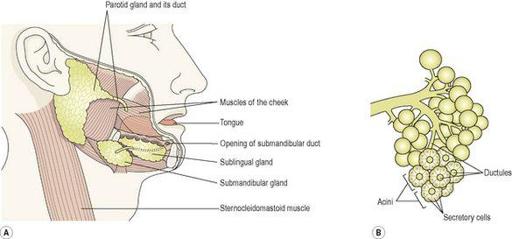Ross & Wilson Anatomy and Physiology in Health and Illness (133 page)
Read Ross & Wilson Anatomy and Physiology in Health and Illness Online
Authors: Anne Waugh,Allison Grant
Tags: #Medical, #Nursing, #General, #Anatomy

Figure 12.12
A section of a tooth.
In the centre of the tooth is the
pulp cavity
containing blood vessels, lymph vessels and nerves, and surrounding this is a hard ivory-like substance called
dentine
. Outside the dentine of the crown is a thin layer of very hard substance, the
enamel
. The root of the tooth, on the other hand, is covered with a substance resembling bone, called
cement
, which secures the tooth in its socket. Blood vessels and nerves pass to the tooth through a small foramen (hole) at the apex of each root.
Blood supply
Most of the arterial blood supply to the teeth is by branches of the
maxillary arteries
. The venous drainage is by a number of veins which empty into the
internal jugular veins
.
Nerve supply
The nerve supply to the upper teeth is by branches of the
maxillary nerves
and to the lower teeth by branches of the
mandibular nerves
. These are both branches of the
trigeminal nerves
(5th cranial nerves) (see
p. 166
).
Salivary glands (
Fig. 12.13
)
Figure 12.13
A.
The position of the salivary glands.
B.
Enlargement of part of a gland.
Learning outcomes
After studying this section, you should be able to:
describe the structure and the function of the principal salivary glands
explain the role of saliva in digestion.
Salivary glands release their secretions into ducts that lead to the mouth. There are three main pairs: the parotid glands, the submandibular glands and the sublingual glands. There are also numerous smaller salivary glands scattered around the mouth.
Parotid glands
These are situated one on each side of the face just below the external acoustic meatus (see
Fig. 8.1, p. 186
). Each gland has a
parotid duct
opening into the mouth at the level of the second upper molar tooth.
Submandibular glands
These lie one on each side of the face under the angle of the jaw. The two
submandibular ducts
open on the floor of the mouth, one on each side of the frenulum of the tongue.
Sublingual glands
These glands lie under the mucous membrane of the floor of the mouth in front of the submandibular glands. They have numerous small ducts that open into the floor of the mouth.
Structure of the salivary glands
The glands are all surrounded by a
fibrous capsule
. They consist of a number of
lobules
made up of small acini lined with
secretory cells
(
Fig. 12.13B
). The secretions are poured into ductules that join up to form larger ducts leading into the mouth.
Blood supply
Arterial supply is by various branches from the external carotid arteries and venous drainage is into the external jugular veins.
Composition of saliva
Saliva is the combined secretions from the salivary glands and the small mucus-secreting glands of the oral mucosa. About 1.5 litres of saliva is produced daily and it consists of:
•
water
•
mineral salts
•
a digestive enzyme: salivary amylase
•
mucus
•
lysozyme
•
immunoglobulins
•
blood-clotting factors.
Secretion of saliva
Secretion of saliva is under autonomic nerve control. Parasympathetic stimulation causes profuse secretion of watery saliva with a relatively low content of enzymes and other organic substances. Sympathetic stimulation results in secretion of small amounts of saliva rich in organic material, especially from the submandibular glands. Reflex secretion occurs when there is food in the mouth and the reflex can easily become
conditioned
so that the sight, smell and even the thought of food stimulates the flow of saliva.
Functions of saliva
Chemical digestion of polysaccharides
Saliva contains the enzyme
amylase
that begins the breakdown of complex sugars, including starches, reducing them to the disaccharide maltose. The optimum pH for the action of salivary amylase is 6.8 (slightly acid). Salivary pH ranges from 5.8 to 7.4 depending on the rate of flow; the higher the flow rate, the higher is the pH. Enzyme action continues during swallowing until terminated by the strongly acidic pH (1.5 to 1.8) of the gastric juices, which degrades the amylase.
Lubrication of food
The high water content means that dry food entering the mouth is moistened and lubricated by saliva before it can be made into a
bolus
ready for swallowing.
Cleaning and lubricating the mouth
An adequate flow of saliva is necessary to clean the mouth, and to keep it soft, moist and pliable. It helps to prevent damage to the mucous membrane by rough or abrasive food.
Non-specific defence
Lysozyme, immunoglobulins and clotting factors present in saliva combat invading microbes.
Taste
The taste buds are stimulated only by chemical substances in solution and therefore dry foods only stimulate the sense of taste after thorough mixing with saliva. The senses of taste and smell are closely linked and involved in the enjoyment, or otherwise, of food (see
Ch. 8
).
Pharynx
Learning outcome
After studying this section, you should be able to:
describe the structure of the pharynx.


